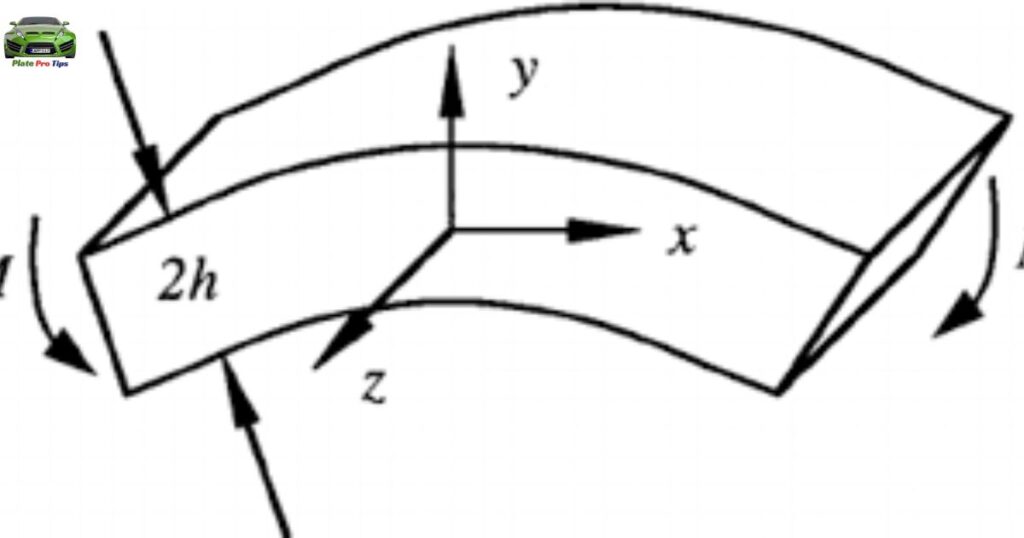Bending license plates is a practice often done to avoid detection by traffic cameras or law enforcement. It involves altering the plate’s shape, typically by bending the corners upward or downward. This action can obscure the plate’s numbers and letters, making it harder to read. However, it is illegal in many places and can result in fines or penalties if caught.
Curious about why some drivers bend their license plates? It’s a tactic that sparks intrigue and raises eyebrows on roads worldwide. But what’s the reason behind this seemingly clandestine maneuver? Unveil the mystery behind why do people bend their license plates and gain insight into this controversial practice.
Bending license plates is a method some drivers use to evade detection by traffic cameras or law enforcement. By altering the plate’s shape, such as bending the corners, they aim to obscure the numbers and letters, making it harder to identify their vehicle. However, this practice is illegal in many places and can lead to fines or other penalties if caught.
The Motivation Behind License Plate Bending
The motivation behind license plate bending often stems from a desire to avoid being easily identified by traffic cameras or law enforcement. By bending the license plate, individuals believe they can obscure the numbers and letters, making it more difficult for authorities to track their vehicle’s movements. This tactic is often employed by those who wish to evade fines or penalties associated with traffic violations or other legal infractions.
However, it’s important to note that bending license plates is illegal in many jurisdictions and can result in serious consequences if caught. Despite the perceived benefits, the risks involved in altering license plates far outweigh any potential advantages. If you’re curious about what FP stands for on a license plate, it’s crucial to follow legal avenues to obtain that information rather than attempting to alter or manipulate the plate itself.
The Art of License Plate Bending
The art of license plate bending involves a creative and often clandestine approach to altering the appearance of one’s vehicle’s identification. This practice, while controversial and potentially illegal, showcases the ingenuity and resourcefulness of individuals seeking to evade detection.
However, it’s essential to recognize the legal implications and potential dangers associated with this art form. Engaging in license plate bending may result in fines, penalties, or even legal action if caught. Moreover, prioritizing evasion over compliance with traffic laws undermines the importance of accountability and road safety.
Common Reasons for Bending Plates

Common reasons for bending license plates often revolve around evading detection or maintaining privacy. Some individuals bend their plates to obscure them from traffic cameras or law enforcement, believing that altering the plate’s shape can make it more difficult to identify their vehicle. This practice is often associated with a desire to avoid fines or penalties for traffic violations or other legal infractions.
However, it’s essential to recognize the potential consequences of bending license plates. Engaging in this behavior is typically illegal and can lead to fines, penalties, or even legal action if caught. Moreover, prioritizing evasion over compliance with traffic laws undermines the importance of accountability and road safety.
License Plate Bending as a Pastime

Common reasons for bending license plates often revolve around attempts to avoid detection or evade accountability. Some individuals bend their plates to obstruct them from traffic cameras or law enforcement, believing that altering the plate’s shape can make it more challenging to identify their vehicle. This practice is often linked to a desire to circumvent fines or penalties for traffic violations or other legal infractions.
However, it’s crucial to acknowledge the potential consequences of bending license plates. Engaging in this behavior is typically illegal and can result in fines, penalties, or legal repercussions if discovered. Furthermore, prioritizing evasion over compliance with traffic laws undermines the importance of accountability and compromises road safety.
License Plate Bending Through the Years
License plate bending has been a controversial practice that has evolved over the years alongside advancements in technology and changes in enforcement tactics. Initially, bending license plates may have been a crude attempt to obscure identification from manual observation by law enforcement. However, with the proliferation of traffic cameras and automated systems for monitoring, the practice has taken on new significance.
Despite the evolving methods and motivations for license plate bending, it remains a contentious issue with legal implications. Many jurisdictions consider the deliberate alteration of license plates to evade identification as illegal and punishable by fines or penalties.
Bending License Plates Legal Implications

The act of bending license plates carries significant legal implications that vary depending on jurisdiction. In many places, deliberately altering license plates to obscure identification is considered illegal and punishable by fines or penalties. Law enforcement agencies view this practice as an attempt to evade accountability for traffic violations or other legal infractions, undermining the integrity of road safety measures.
Engaging in license plate bending not only violates legal statutes but also undermines the importance of transparency and accountability on the roads. Drivers should be aware of the potential consequences associated with altering their license plates, including fines, legal repercussions, and the risk of compromising their safety and the safety of others.
The Future of License Plate Bending
The future of license plate bending remains uncertain as technology continues to advance and law enforcement agencies develop more sophisticated methods for monitoring and identifying vehicles. With the increasing prevalence of automated surveillance systems and advancements in image recognition technology, evading detection through license plate bending may become even more challenging.
Furthermore, as concerns about privacy and data protection grow, there may be increased scrutiny and regulation surrounding the use of surveillance technology, including traffic cameras. This could lead to stricter enforcement of laws against license plate bending and other attempts to obscure vehicle identification.
Bent License Plate Meaning
A bent license plate typically carries a symbolic or practical meaning depending on the context in which it’s found. In some cases, a bent license plate may indicate that the vehicle’s owner is attempting to evade detection by traffic cameras or law enforcement. This bending could be deliberate, with the intention of obscuring the plate’s numbers and letters to avoid identification.
Alternatively, a bent license plate may simply be the result of accidental damage or wear and tear. In these instances, the bending may not hold any particular meaning beyond indicating the need for repair or replacement. Regardless of the reason behind the bending, it’s crucial for drivers to ensure that their license plates remain visible and legible to comply with legal requirements and maintain road safety standards.
Motivation Behind Plate Bending
Plate bending, a fundamental process in engineering and manufacturing, is motivated by the need to shape metallic plates into various forms to meet specific design requirements. The primary motivation behind plate bending lies in its ability to transform flat sheets of metal into curved or angular shapes, essential for constructing a wide range of structures and components such as beams, columns, shells, and even entire buildings.
Furthermore, the motivation behind plate bending also stems from its crucial role in improving the strength-to-weight ratio of structural elements. By curving or bending metal plates, engineers can distribute stress more effectively, reducing material usage without compromising structural integrity.
Art of Plate Bending

The art of plate bending is a craft that merges precision engineering with creative ingenuity to transform flat sheets of metal into intricate and functional shapes. Beyond its technical aspects, plate bending involves a deep understanding of material properties, mechanical principles, and craftsmanship techniques.
Moreover, plate bending is more than just a mechanical process; it embodies a fusion of practicality and aesthetic sensibility. Artists and designers leverage the versatility of plate bending to realize their creative visions, pushing the boundaries of form and function.
Reasons for Bending Plates
Bending plates serves a multitude of purposes across various industries, driven by the need for custom shapes and structural adaptability. One primary reason for bending plates is to enhance structural integrity and load-bearing capacity in constructions like bridges, buildings, and industrial equipment. By curving plates, engineers can distribute stresses more effectively, reducing the risk of failure and increasing the overall strength-to-weight ratio of the structure.
Furthermore, bending plates offers a cost-effective solution by optimizing material usage and minimizing waste. Instead of relying on bulky solid components, bending enables the utilization of thinner plates, reducing the overall weight of structures while maintaining their strength and functionality. This efficiency not only translates to savings in material costs but also facilitates easier transportation and installation.
Plate Bending as a Pastime
Plate bending as a pastime represents a unique blend of craftsmanship, creativity, and relaxation. For hobbyists and enthusiasts, it offers a hands-on way to explore metalworking techniques while unleashing their artistic flair. Whether it’s shaping simple curves or experimenting with intricate designs, plate bending allows individuals to express their creativity and ingenuity in a tangible and rewarding manner.
Moreover, plate bending as a pastime encourages camaraderie and community among like-minded individuals. Whether through local clubs, online forums, or workshops, enthusiasts can connect, share ideas, and learn from each other’s experiences. This sense of community fosters collaboration, inspiration, and skill development, enriching the hobbyist experience and fostering lasting friendships.
Historical View of Plate Bending
The historical view of plate bending reveals a fascinating evolution of techniques and technologies dating back centuries. Early civilizations employed rudimentary methods, such as hammering and heating, to bend metal plates for various purposes, including weaponry, utensils, and architectural embellishments.
Furthermore, the historical view of plate bending underscores its pivotal role in shaping human progress and innovation across industries. From the Industrial Age to the present day, plate bending has continuously evolved to meet the demands of evolving technologies and design aesthetics.
FAQ’S
Why do some people bend their license plates?
People may bend their license plates in an attempt to avoid detection by traffic cameras or automated license plate readers (ALPRs).
Is bending license plates legal?
No, bending license plates is typically illegal in most jurisdictions. It’s considered a form of license plate tampering or obstruction, which violates traffic laws and regulations.
Are there any legitimate reasons for bending license plates?
Generally, no. Bending license plates is primarily associated with attempts to evade law enforcement or toll collection systems.
What are the consequences of bending license plates?
The consequences of bending license plates vary depending on local laws and regulations.
How can individuals protect their license plates without bending them?
Instead of bending license plates, individuals can explore legal alternatives to protect their privacy or prevent theft.
Conclusion
Bending license plates is often attempted as a misguided effort to evade detection by traffic cameras or automated license plate readers. However, it is important to note that such actions are illegal and can lead to serious consequences. While concerns about privacy or avoiding tolls may arise, there are legal alternatives available for individuals seeking to protect their license plates, such as using compliant license plate covers or frames.
Ultimately, adherence to traffic laws and regulations is crucial for maintaining safety on the roads and ensuring accountability for all drivers. Therefore, instead of resorting to unlawful tactics like bending license plates, individuals should explore lawful means of addressing their concerns while upholding the integrity of the law.

I’m Shoaib, a passionate blogger with 5 years of experience. I love writing about tech. My goal is to share useful information and insights with you. Explore my website to discover exciting content on various topics!




